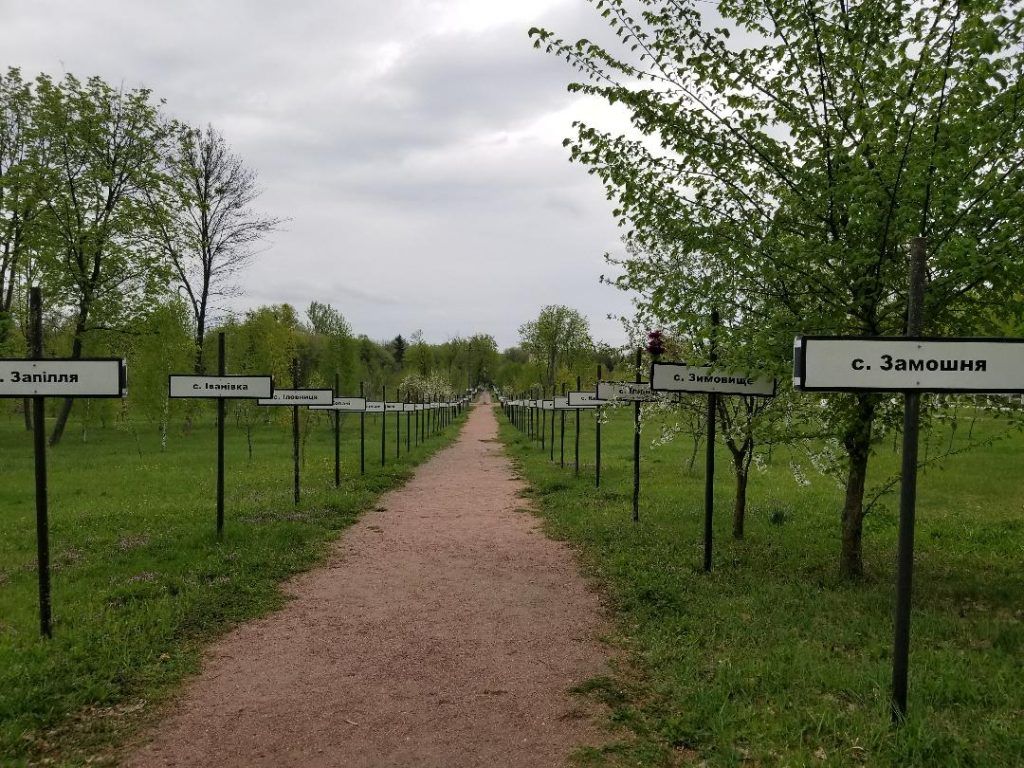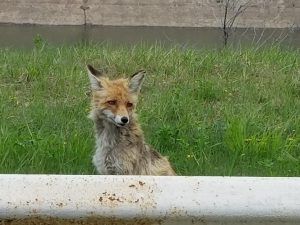It’s not radioactive Disneyland: Visit Chernobyl, but respect it.
By Margarita Kalinina-Pohl | April 26, 2021
 Alley of abandoned villages - 162 plaques with the names of permanently evacuated settlements during 1986-1991 after the Chernobyl accident. Credit: Margarita Kalinina-Pohl (2018).
Alley of abandoned villages - 162 plaques with the names of permanently evacuated settlements during 1986-1991 after the Chernobyl accident. Credit: Margarita Kalinina-Pohl (2018).
This year is rich in commemorative anniversaries of natural and man-made disasters stemming from the use of nuclear energy for peaceful and military purposes. In March, we solemnly observed the 10th anniversary of the Fukushima nuclear disaster. On April 26, we marked 35 years since the largest nuclear accident at the Chernobyl Nuclear Power Plant. At end of August, the international nuclear nonproliferation and antinuclear movement will celebrate the 30th anniversary of the closure of the Semipalatinsk nuclear testing site. Besides catastrophic impacts on humans and environments, these grim places have something else in common; they have emerged as nuclear tourist destinations, with the Chernobyl (Chornobyl in Ukrainian) Exclusion Zone especially popular among aficionados of “dark” tourism.
Images of the desolate town of Pripyat with graffiti-laden buildings and its iconic, never-used Ferris wheel, adjacent villages with abandoned and overgrown houses, a kindergarten with mutilated dolls and teddy bears, and Duga—a gargantuan steel structure used as part of the Soviet missile defense early-warning radar network—flood social media. Selfies by ordinary tourists or professional photos featuring scantily clad models depict Chernobyl today as a nuclear theme park or an Armageddon landscape. Some pose with resettlers—villagers who returned to their homes following the disaster despite government warning and who continue to live in small dilapidated villages without running water. Others are pictured with Geiger counters wearing hazmat suits or plastic raincoats, depending on what a particular tour operator has in stock. There is an abundance of kitsch souvenirs at nearby kiosks at the Chernobyl Exclusion Zone entrance checkpoint where tourists are welcomed with blasting pop music. The zone’s entrance does resemble a theme park entrance with buses and tourists smoking and casually chatting while waiting for their turn to enter. Permission is required, which can be acquired as part of an organized tour or through a professional visit arranged through the State Agency of Ukraine on the Exclusion Zone Management.

What is lesser known to most visitors is that the state agency also manages the Chernobyl Exclusion Zone infrastructure, including eight state enterprises with over 6,000 personnel. The Territory of Special Industrial Use, encompassing a 6-mile (10-km) radius around the Chernobyl Nuclear Power Plant, houses radioactive waste and spent nuclear fuel storage facilities and will never be used or inhabited by people again. The Chernobyl Radiation and Ecological Biosphere Reserve, encompassing a 19-mile (30-km) radius of the plant, has become the largest environmental reserve in Ukraine, with more than 400 species of animals, birds, and fish. On the way to Reactor Unit 4, one can spot a fox named Simon (Semyon). Simon positions himself by a road leading to the reactor site and is rewarded with treats from employees and visitors.
Despite the presence of humans, animals, and lush vegetation, the Chernobyl Exclusion Zone remains one of the most contaminated places in the world with high levels of radioactive isotopes Cs-137 and Sr-90, especially in the zone’s so-called Red Forest, named for the brown color of dead pines which absorbed high levels of radiation after the reactor meltdown. The exclusion zone is ravaged by occasional forest fires, with the most recent fires in April, 2020. These fires can potentially release radioactive substances into the atmosphere by burning contaminated vegetation. As that last fire took place during the COVID-19 pandemic, the human traffic in the region was minimal, which was a blessing to exclusion zone officials and firefighters.

My two visits to the Chernobyl Exclusion Zone before the pandemic led me to reflect on how to enhance visitors’ experiences there and at other nuclear disaster sites.
Most intrepid tourists I observed in Pripyat seemed to neglect that they were entering a territory of the largest anthropogenic disaster in the history of humankind. Due to the secrecy the Soviets employed in trying to cover up the Chernobyl accident, it is not feasible to provide exact estimates of how many people died and how many would die from radiation exposure. There is a widespread belief that millions of people were exposed to high levels of radiation. According to the 2005 UN report, fewer than 50 deaths had been directly attributed to radiation from the disaster, and the majority of these were first responders. The report’s grim estimate was that about 4,000 people could eventually die of radiation exposure

State Agency of Ukraine officials speak of “controlled access” and “visitors” instead of “tourism” and “tourists” to emphasize that all exclusion zone visitors and their actions are controlled and accounted for. Several authorized tour operators bring busloads of adventurers wishing to experience Chernobyl firsthand. There are plans to offer a tour to the Reactor 4 control room for those who dare to visit the ground zero.
A quick look at photos taken by exclusion zone visitors pouring onto social media makes one question their actions, which are often indicative of disrespectful and negligent behavior. This has caused HBO’s Chernobyl producers to plead with tourists to be respectful of the tragedy behind the scene when taking pictures at the zone.
Designating Chernobyl as an official tourist destination has been on Ukrainian President Zelensky’s agenda, as well as fighting corruption at the exclusion zone, such as bribes that security officials collect from tourists, the illegal export of scrap, and the use of natural resources. What is lacking is a visitor center with a collection of declassified photos, documents, and oral histories of people who lived through the accident. This could be opened as a branch of the Ukrainian National Chernobyl Museum in Kyiv, which would offer a starting point for each tourist.
It is important to keep the memory of Chernobyl alive. Turning its exclusion zone into an open-air living museum will help preserve it for future generations, but only if we treat this place with respect and understanding that this is neither a theme park based on a popular post-apocalyptic video game nor an Instagram Hotspot. Chernobyl is not trendy and is not a popular culture phenomenon. Instead, it should be considered as a textbook example of grave consequences on people and the environment caused by a flawed reactor design combined with a human error. Most of all, this is a place of a large-scale humanitarian catastrophe that affected millions of lives and still presents environmental and health risks.

“Dark” tourism, defined as traveling to sites associated with death and destruction, has been growing steadily since the 1990s. Nuclear tourism as a subset of this trend has become popular as many former nuclear sites become accessible. Fukushima Daiichi Nuclear Plant is one such destination where people can book a tour for an “unforgettable experience.” Some Kazakh travel agencies are attempting, with less success than their Ukrainian counterparts, to organize tours to the former Soviet nuclear testing site called Semipalatinsk Testing Site.
Most countries and companies put their tours on hold due to the COVID-19 pandemic. Once travel restrictions are lifted, people hungry for new experiences will venture out to places, including Chernobyl, Fukushima, and the former Semipalatinsk Testing Site. While waiting for the world to open, nuclear tourist wannabes can spend time reading about places they want to visit. If you or someone you know is considering the adventure of a lifetime to the aforementioned sites, here is a reading list to check out: Chernobyl Prayer: Voices from Chernobyl by Nobel Prize in Literature recipient Svetlana Alexievich, On the Brink: The Inside Story of Fukushima Daiichi by Ryuosha Kadota, et al., and Atomic Steppe: How Kazakhstan Gave Up the Bomb by Togzhan Kassenova (forthcoming). These and other books on similar topics will serve as guides to the history of nuclear disasters and nuclear tests which occurred at these places and will best prepare prospective visitors to experience these places in meaningful and respectful ways.
Together, we make the world safer.
The Bulletin elevates expert voices above the noise. But as an independent nonprofit organization, our operations depend on the support of readers like you. Help us continue to deliver quality journalism that holds leaders accountable. Your support of our work at any level is important. In return, we promise our coverage will be understandable, influential, vigilant, solution-oriented, and fair-minded. Together we can make a difference.
Keywords: Chernobyl, Chernobyl disaster, Fukushima, Fukushima Daiichi, dark tourism, nuclear tourism
Topics: Nuclear Energy, Nuclear Risk
















One of the stories that I wrote – but have never published – focuses on a woman whose ancestors immigrated to the US from Pripyat in the late 1800s. Upon earning a steady income, she starts making yearly pilgrimages to her ancestral town…until the nuclear disaster.